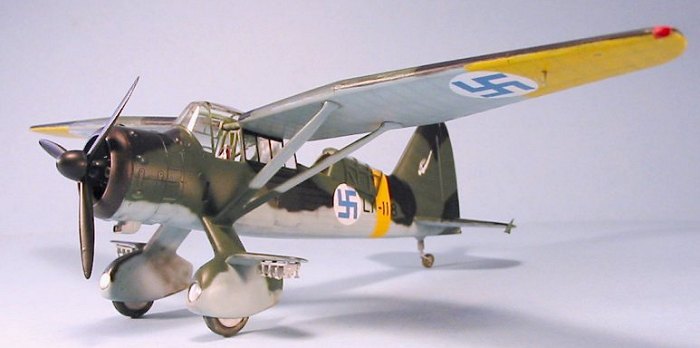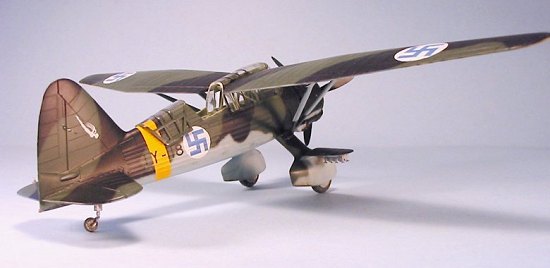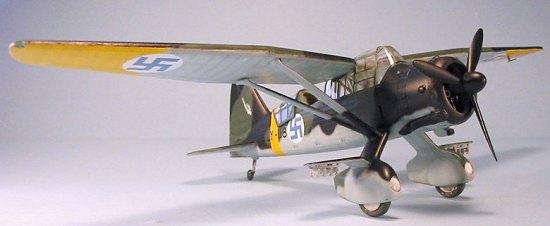
Gavia 1/48 Lysander III
|
KIT # |
? |
|
PRICE: |
$45.00 |
|
DECALS: |
Three options |
|
REVIEWER: |
|
|
NOTES: |

|
HISTORY |
The original
use of aircraft in war was for battlefield reconnaissance. This remained
a primary task for the Royal Flying Corps and Royal Air Force throughout
the First World War. The original Corps Reconnaissance aircraft was the
B.E.2 series, an airplane designed for "inherent stability," which
literally found itself unable to get out of its own way after the birth
of the single-seat fighter; the largest number of one single type of
aircraft shot down by Manfred von Richtofen were the 35 B.E.2s in his
score of 80. The replacement for the B.E.2 was the R.E.8, which had only
marginally better performance, though it did not have inherent
stability. The one Corps Reconnaissance airplane that was truly combat
worthy was the Bristol Fighter, which was so good that it remained the
primary equipment of what later became Army Cooperation
 Command until its
replacement by the Hawker Hector - a derivative of the Hart series - in
the early 1930s. Unfortunately, the aircraft chosen to replace the
Hector - which was quite a performer in its day - was the Westland Lysander, an airplane that seemed to harken back to the days of the B.E.2
in terms of its ability to survive in modern air combat.
Command until its
replacement by the Hawker Hector - a derivative of the Hart series - in
the early 1930s. Unfortunately, the aircraft chosen to replace the
Hector - which was quite a performer in its day - was the Westland Lysander, an airplane that seemed to harken back to the days of the B.E.2
in terms of its ability to survive in modern air combat.
In 1935 the Air Ministry issued Specification A.39/34 calling for a two-seat army cooperation aircraft to replace the Hawker Hector. One of the companies submitting a design proposal was Westland Aircraft Limited, which had been building the Hector under license from Hawker.
Westland's response to A.39/34 was called the P.8. It was primarily the work of Arthur Davenport, under the technical direction of W.E.W.(Teddy) Petter, grandson of the company's founder, who would later go on to be the designer of both the Canberra and the Gnat. In creating the P.8, Petter sought opinions from the squadrons that would operate the new aircraft. The consensus of opinion favored an airplane with good visibility from the cockpit, the special performance necessary to take-off and land from extremely small areas, and excellent handling at very slow flying speeds.
The resulting
design was definitely distinctive. Its wooden, fabric-covered, wings had
full span automatic leading edge slats that operated from any position
between closed and full open, allowing maximum use of this lift device,
while the flaps could be lowered to any position between full up and full
down depending on sp eed. The Lysander was thus able to land and take off
at extremely low speeds from very small fields, operating comfortably
from pastures, fields, and even clearings in the forest . It was thought
this capability would be important for front line usage of the aircraft
in a war that was contemplated at the time to be a replay of the Western
Front of World War I.
eed. The Lysander was thus able to land and take off
at extremely low speeds from very small fields, operating comfortably
from pastures, fields, and even clearings in the forest . It was thought
this capability would be important for front line usage of the aircraft
in a war that was contemplated at the time to be a replay of the Western
Front of World War I.
To maximize cockpit visibility, Davenport raised the wing to the top of the canopy and braced it with two pairs of sturdy struts. To boost the low-speed characteristics of the airfoil, the wing was thickest at about mid-span but shrank by nearly half at the wing roots. Viewed head-on, the wing bent like the wing of a seagull. The inboard, leading edges tapered toward the tail to allow the pilot to see through the top of the canopy during very steep turns, and the outboard trailing edges tapered forward to give the airplane a good roll rate at slow speeds.
The distinctive landing gear had a landing light and machine gun mounted inside the enormous fairings, while stub wings could be attached to hold light bombs, supply containers, or other stores.
In September 1936, the Air Ministry chose the Westland design and ordered 169 aircraft. The British Army custom at the time was to name cooperation aircraft after classical warriors. "Lysander" was chosen, after a Spartan admiral who defeated the Athenian fleet during the Peloponnesian War in 405 B.C.
By the time the
war came in September 1939, seven Lysander squadrons were sent to France
with the Advanced Air Striking Force component of the British
Expeditionary Force. When the Germans attacked in the west in May 1940,
the slow an d poorly armed Lysanders were decimated. The airplane excelled
in the role for which it was designed, but it stood no chance against
overwhelming numbers of German fighter aircraft. Lysanders were also not
suited for ground attack, since they were too slow and their bomb load of
a maximum of eight 20-lb. bombs was insignificant.
d poorly armed Lysanders were decimated. The airplane excelled
in the role for which it was designed, but it stood no chance against
overwhelming numbers of German fighter aircraft. Lysanders were also not
suited for ground attack, since they were too slow and their bomb load of
a maximum of eight 20-lb. bombs was insignificant.
After the retreat from France, many Lysanders were reassigned to new roles. Some remained in use for army cooperation, and saw service in North Africa following the Italian decision to join the war. Even against the Italians, the Lysander was incapable of surviving in an air combat environment. During the Battle of Britain, Lysanders began to be used in the air-sea rescue role, and seven squadrons were ultimately deployed around the United Kingdom before the Lysander was replaced in late 1942.
In 1941, the
ultimate Lysander mission began to take shape. The Special Operations
Executive, formed to support resistance efforts on the European
continent, formed three units - 138, 161 and 357 Special Duties squadrons
- and began  to fly the Lysander to aid the various resistance movements,
dropping ammunition, explosives, radios and other equipment and
transporting agents to and from the continent. The Lysander IIIA(SD) was
modified specifically for this role, with the gunners seat and weapons
removed from the rear cockpit and adding a ladder so that agents could
quickly board or exit the airplane, while an external fuel tank was added
to increase range. These missions were possible only because of the
outstanding STOL (short takeoff and landing) performance of the Lysander.
to fly the Lysander to aid the various resistance movements,
dropping ammunition, explosives, radios and other equipment and
transporting agents to and from the continent. The Lysander IIIA(SD) was
modified specifically for this role, with the gunners seat and weapons
removed from the rear cockpit and adding a ladder so that agents could
quickly board or exit the airplane, while an external fuel tank was added
to increase range. These missions were possible only because of the
outstanding STOL (short takeoff and landing) performance of the Lysander.
Canada, Turkey, Ireland, Portugal, South Africa, and Finland flew the Lysander, while the U.S. 8th Air Force used 25 Lysanders as aerial gunnery target tugs. The Canadians flew more Lysanders than anyone outside England. They also built 225 aircraft and were tooling-up to supply more airframes to ship to England for final assembly when the war ended.
The Finnish Air Force was provided with Lysanders as part of the British reinforcement during the Winter War, though only a few Mk.I Lysanders arrived in time to see action in that conflict. The 16 Lysanders - six Mk.Is and ten Mk.IIIs - were used for battlefield reconnaissance and for nighttime harassment raids over Soviet forces during the Continuation War. The survivors remained in Finnish service until 1946.
|
THE KIT |
 Until the
arrival of Gavia's Lysander two years ago, the only 1/48 Lysander kit was
the venerable Hawk version, which was first released around 1962 if
memory serves. For its time, it was a good kit, but it has long been in
need of replacement, since it did not have much of a cockpit interior,
and there were considerable accuracy issues around what detail was
provided.
Until the
arrival of Gavia's Lysander two years ago, the only 1/48 Lysander kit was
the venerable Hawk version, which was first released around 1962 if
memory serves. For its time, it was a good kit, but it has long been in
need of replacement, since it did not have much of a cockpit interior,
and there were considerable accuracy issues around what detail was
provided.
The Gavia kit is not without its own problems, this being primarily the fact that while the wing struts are the proper length, the positioning holes in the lower wing surface are too far out on the wing, resulting in a very significant "droop" if the modeler follows the instructions and uses those positioning holes.
Past that, the kit does provide an acceptably-detailed cockpit. The engine cowling is accurate for a Pegasus-engined Mk.I or Mk.III - the major versions to see operational use - and the multi-part canopy is acceptably clear. Decals are provided for one Finnish and two British Lysanders.
The kit has also been released with additional parts to allow creation of the Mk.III Special Duties aircraft. Eduard - the "parent" of Gavia - also released a "Profipack" Lysander kit with a fret of photo-etch details including a new instrument panel and seat belts.
|
CONSTRUCTION |
 Since I was
aware of the problem with the strut guide holes in the lower wing
surfaces, the first thing I did was fill those in with some Evergreen
rod, and then assemble the wings, horizontal stabilizers and main landing
gear as sub assemblies. I followed that by building the engine -
including the use of Evergreen rod for the sleeve valves on the pistons,
and then assembled the four-piece engine cowling, which was a bit
"fiddly" until the glue set up fully.
Since I was
aware of the problem with the strut guide holes in the lower wing
surfaces, the first thing I did was fill those in with some Evergreen
rod, and then assemble the wings, horizontal stabilizers and main landing
gear as sub assemblies. I followed that by building the engine -
including the use of Evergreen rod for the sleeve valves on the pistons,
and then assembled the four-piece engine cowling, which was a bit
"fiddly" until the glue set up fully.
I then turned to the fuselage. I painted the interior of the fuselage brick red, overspraying it with some Gunze "Sail Color" to look like the doped fabric interior of a RAF airplane. When that was dry the fabric areas were masked off and the rest of the fuselage interior and all the parts for the cockpit, were painted with Gunze H-107 Light Green, which is a good approximation of British Interior Green. I freehanded the rib detail with a 0000 brush. Detail parts were painted black, and the cockpit interior was then assembled per the instructions.
 I have heard
from other modelers that the cockpit assembly was a bit small for the
fuselage when it was inserted, but that was not what I found with this
kit. In fact, I had to sand down the fuselage structure toward the rear
in order for it to fit inside the fuselage without creating a huge gap
along the centerline. I finished off by attaching the landing gear and
the horizontal stabilizer.
I have heard
from other modelers that the cockpit assembly was a bit small for the
fuselage when it was inserted, but that was not what I found with this
kit. In fact, I had to sand down the fuselage structure toward the rear
in order for it to fit inside the fuselage without creating a huge gap
along the centerline. I finished off by attaching the landing gear and
the horizontal stabilizer.
After Futuring the clear plastic, I assembled the canopy. I discovered that the main side panels are warped. One was warped so badly that even dipping it in hot water only got rid of a bit of the warp. I solved this by cutting off the portion beside the pilot's cockpit and deciding this airplane would be flown with the cockpit open.
Once all this assembly was completed and the various seams had been dealt with using Mr. Surfacer 500, the model was ready for paint. I left the wings off until after the model was painted and decaled.
|
CAMOUFLAGE & MARKINGS |
 Painting:
Painting:
I had decided to do a Finnish airplane, using the old Aeromaster Lysander decal sheet, which was better quality than the kit-supplied decal sheet.
After pre-shading the model, I painted the yellow Eastern Front tactical markings, and masked them off. I then painted the lower fuselage and wings with Gunze-Sangyo RLM65, a good approximation of Finnish light blue. The upper surface was camouflaged using Tamiya XF-18 Semi-Gloss Black, and Gunze-Sangyo US Medium Green FS34092. I used Model Master Metalizer "Burnt Iron" for the collector ring and exhaust on the engine cowling.
When all this was dry, the model was Futured for decaling.
Decals:
The Aeromaster decals went down with no problem, though it turned out the national insignias were not completely opaque, since you can see the yellow through the lower wing surface insignias.
|
FINAL CONSTRUCTION |
 I had thought
to scratchbuild skis, but was not satisfied with the result, so this
airplane is as it would have been while being operated during the summer
in Finland, with the standard wheeled landing gear. I attached each
wing, with the outer end of the wing strut glued to the first raised rib
inboard of where the mounting holes had been, which gave the wings the
correct amount of dihedral. I then "muddied up" the wheels and attached
them, and applied "exhaust stain" with Tamiya Semi-Gloss Black thinned 80
percent with alcohol.
I had thought
to scratchbuild skis, but was not satisfied with the result, so this
airplane is as it would have been while being operated during the summer
in Finland, with the standard wheeled landing gear. I attached each
wing, with the outer end of the wing strut glued to the first raised rib
inboard of where the mounting holes had been, which gave the wings the
correct amount of dihedral. I then "muddied up" the wheels and attached
them, and applied "exhaust stain" with Tamiya Semi-Gloss Black thinned 80
percent with alcohol.
|
CONCLUSIONS |
It was said in the RAF that there were two kinds of airplane types used: Lysanders and everything else. The Lysander has a very distinctive look, and makes a nice addition to my Finnish Air Force collection.
Tom CleaverSeptember 2003
Copyright ModelingMadness.com
Review kit courtesy Eduard/Gavia.
If you would like your product reviewed fairly and quickly, please contact me or see other details in the Note to Contributors.